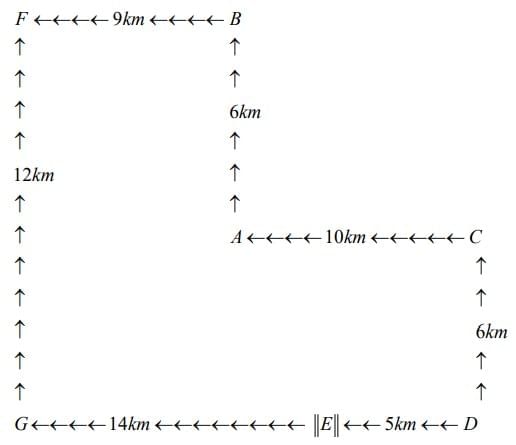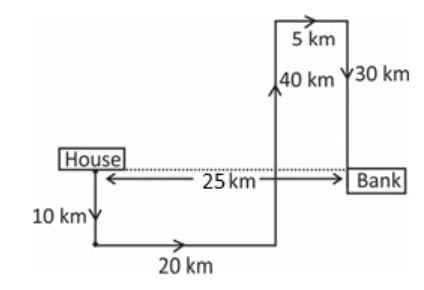Previous Year Topic Wise Questions With Solutions: Direction Sense Test | CSAT Preparation - UPSC PDF Download
Q1. There are 7 places A, B, C, D, E, F and G in a city connected by various roads AB, AC, CD, DE, BF, EG and FG. A is 6 km south of B. A is 10 km west of C. D is 5 km east of E. C is 6 km north of D. F is 9 km west of B. F is 12 km north of G. A person travels from D to F through these roads. What is the distance covered by the person? (2025)
(a) 20 km
(b) 25 km
(c) 31 km
(d) 37 km
 View Answer
View Answer 
Ans: (c)
The city map:
If a person wants to travel from D to F, he can opt one of the following two routes:
Route I: DG (5 km + 14 km) + GF (12 km) = 19 km + 12 km = 31 km
Route II: DC (6 km) + CA (10 km) + AB (6 km) + BF (9 km) = 6 km + 10 km + 6 km + 9 km
= 31 km
In both cases, he will cover the same distance of 31 km.
Q2. A student appeared in 6 papers. The maximum marks are the same for each paper. His marks in these papers are in the proportion 5 : 6 : 7 : 8 : 9 : 10. Overall he scored 60%. In how many number of papers did he score less than 60% of the maximum marks? (2021)
(a) 2
(b) 3
(c) 4
(d) 5
 View Answer
View Answer 
Ans: (b)
Let total marks in each subject be 100.
Therefore, total marks for all 6 subjects = 600
Overall marks scored = 60% of 600 = 360
According to the question,
5x + 6x + 7x + 8x + 9x + 10x = 360
or 45x = 360
or x = 8
So, marks in the given 6 subjects must be:
5 × 8 = 40
6 × 8 = 48
7 × 8 = 56
8 × 8 = 64
9 × 8 = 72
10 × 8 = 80
Hence, in 3 subjects the student has scored less than 60% marks.
Q3. A bank employee drives 10 km towards South from her house and turns to her left and drives another 20 km. She again turns left and drives 40 km, then she turns to her right and drives for another 5 km. She again turns to her right and drives another 30 km to reach her bank where she works. What is the shortest distance between her bank and her house? (2021)
(a) 20 km
(b) 25 km
(c) 30 km
(d) 35 km
 View Answer
View Answer 
Ans: (b)
The route taken by the bank employee has been depicted below:
From the diagram, the shortest distance between her house and her bank is 25 km.
Hence, option (b) is the correct answer.
|
205 videos|265 docs|136 tests
|
FAQs on Previous Year Topic Wise Questions With Solutions: Direction Sense Test - CSAT Preparation - UPSC
| 1. What is a Direction Sense Test and why is it important for competitive exams like UPSC? |  |
| 2. How can one effectively prepare for Direction Sense Tests in competitive exams? |  |
| 3. What types of questions are commonly found in Direction Sense Tests? |  |
| 4. Are there any specific strategies to solve Direction Sense Test questions quickly? |  |
| 5. How do Direction Sense Test questions relate to real-life situations? |  |
















